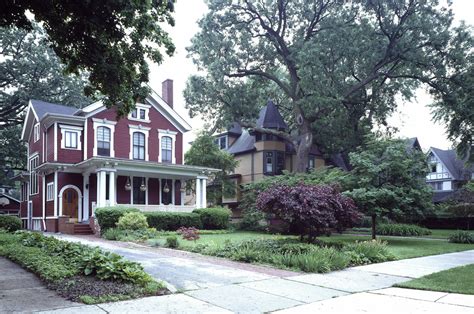Architecture Of The United States

The architecture of the United States is a diverse and complex reflection of the country's history, geography, and cultural influences. From the early colonial period to the present day, American architecture has been shaped by a wide range of factors, including technological advancements, social and economic changes, and the contributions of immigrant cultures. This richness and diversity are evident in the various styles and forms that have evolved over time, each with its own unique characteristics and historical significance.
One of the earliest and most enduring influences on American architecture was the colonial style, which emerged in the 17th and 18th centuries. Characterized by simple, rectangular forms and traditional materials such as wood and brick, colonial architecture was shaped by the practical needs and limited resources of the early settlers. As the colonies grew and prospered, however, architectural styles began to reflect the cultural and economic aspirations of the emerging nation. The Georgian style, with its symmetrical facades and classical details, became a popular choice for wealthy merchants and landowners, while the Federal style, with its lighter, more ornate forms, was often used for public buildings and government institutions.
Key Points
- The architecture of the United States reflects the country's diverse history, geography, and cultural influences.
- Colonial architecture was shaped by practical needs and limited resources, while later styles reflected cultural and economic aspirations.
- The Georgian and Federal styles were popular in the 18th and early 19th centuries, with the latter often used for public buildings and government institutions.
- The mid-19th century saw the emergence of the Gothic Revival and Italianate styles, with the former characterized by pointed arches and the latter by ornate decoration.
- The late 19th and early 20th centuries were marked by the development of the Beaux-Arts style, with its grand, classical forms and monumental scale.
Evolution of Architectural Styles

As the United States expanded and grew, new architectural styles emerged to reflect the changing needs and values of American society. The mid-19th century, for example, saw the rise of the Gothic Revival style, with its characteristic pointed arches, ribbed vaults, and decorative tracery. This style, which was often used for churches and other ecclesiastical buildings, was influenced by the medieval architecture of Europe and reflected the growing interest in historical and cultural heritage. At the same time, the Italianate style, with its ornate decoration, curved lines, and picturesque forms, became popular for domestic architecture, particularly in the Northeast and Midwest.
Regional Variations
Despite the dominance of national styles, regional variations in architecture were also significant, reflecting the unique cultural, geographical, and historical contexts of different parts of the country. In the South, for example, the antebellum style, with its classical columns, balconies, and ornate decoration, was a distinctive feature of plantation architecture, while in the Southwest, the adobe style, with its earthy, organic forms and simple, functional design, was well-suited to the arid climate and available materials. Similarly, in the Northeast, the Shingle style, with its rugged, rustic forms and emphasis on natural materials, was a popular choice for summer homes and coastal resorts.
| Architectural Style | Characteristics | Historical Period |
|---|---|---|
| Colonial | Simple, rectangular forms; traditional materials | 17th-18th centuries |
| Georgian | Symmetrical facades; classical details | 18th century |
| Federal | Lighter, more ornate forms; public buildings | Late 18th-early 19th centuries |
| Gothic Revival | Pointed arches; ribbed vaults; decorative tracery | Mid-19th century |
| Italianate | Ornate decoration; curved lines; picturesque forms | Mid-19th century |

Modern and Contemporary Architecture

The late 19th and early 20th centuries saw the emergence of new architectural styles, including the Beaux-Arts style, with its grand, classical forms and monumental scale, and the Art Deco style, with its geometric shapes, metallic materials, and ornate decoration. These styles, which were often used for public buildings, skyscrapers, and other large-scale developments, reflected the growing confidence and ambition of American society, as well as the increasing influence of international modernism. In the post-war period, the International Style, with its emphasis on functionalism, simplicity, and standardization, became a dominant force in American architecture, while the 1960s and 1970s saw the rise of postmodernism, with its playful, ironic, and often provocative forms.
Sustainability and Environmental Concerns
Today, American architecture is increasingly focused on sustainability and environmental concerns, with a growing emphasis on green building, energy efficiency, and eco-friendly design. This shift reflects not only the growing awareness of environmental issues but also the recognition that buildings and urban environments can have a significant impact on human health, well-being, and quality of life. As architects, engineers, and builders continue to innovate and experiment with new materials, technologies, and design strategies, the future of American architecture is likely to be shaped by a complex interplay of aesthetic, functional, and environmental considerations.
What are some of the key influences on American architecture?
+American architecture has been influenced by a wide range of factors, including cultural and historical heritage, technological advancements, social and economic changes, and the contributions of immigrant cultures.
How has American architecture evolved over time?
+American architecture has evolved significantly over time, reflecting changing social, economic, and cultural conditions, as well as advances in technology and design. From the early colonial period to the present day, a wide range of styles and forms have emerged, each with its own unique characteristics and historical significance.
What are some of the most significant architectural styles in American history?
+Some of the most significant architectural styles in American history include the colonial, Georgian, Federal, Gothic Revival, Italianate, Beaux-Arts, Art Deco, and International Style, among others. Each of these styles reflects the cultural, historical, and technological contexts of its time and has contributed to the rich and diverse architectural heritage of the United States.



